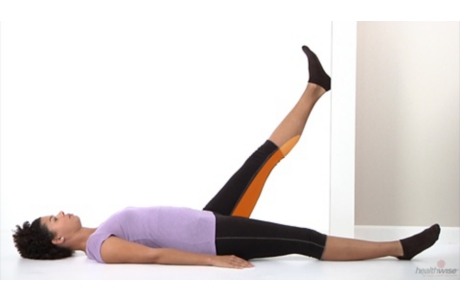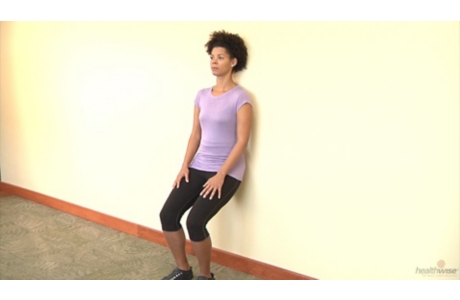Aerobic exercises increase the flow of oxygen to your muscles. This allows your muscles to work longer, helping you do more activities for longer periods of time. These exercises include walking, using a treadmill, and swimming. Daily activities can also be aerobic. These activities include walking your dog, doing housework, and playing with children.
Finding the right activity
Experts say to do regular moderate activity and/or vigorous-intensity activity.
Here are some ideas for both types of activities. You can boost many of the moderate activities in the left column to a vigorous level by doing them faster or harder.
| Moderate intensity | Vigorous intensity |
|---|---|
| General exercise: Brisk walking Light to moderate calisthenics (for example, home exercises, back exercises, getting up and down from the floor) Low-impact aerobic dancing Jogging on a small trampoline Weight lifting, body building, using a lot of effort Light to moderate workouts on gym equipment like Nautilus or Universal machines or a rowing machine | General exercise: Walking uphill, jogging, or running Heavy calisthenics (push-ups, sit-ups, jumping jacks, etc.) High-impact aerobic dancing Jumping rope Using a stair-climber or skiing machine Stationary bicycling, with vigorous effort |
| Water exercises: Treading water with moderate effort Water aerobics or water calisthenics | Water exercises: Swimming laps with fast, vigorous effort Water jogging Treading water with fast, vigorous effort |
| Outdoor activities: Fishing and hunting Tossing and catching a plastic disc Children's games, like hopscotch, 4-square, and dodge ball Playing on playground equipment Shoveling snow | Outdoor activities: Competitive sports like basketball and soccer Hiking with a backpack Mountain biking Ice skating quickly (more than 9 mph) Snowshoeing and cross-country skiing |
| House and yard work: Sweeping, vacuuming, and mopping floors Washing the car with vigorous effort Sweeping the garage, sidewalk, or patio Washing the dog Mowing or raking the lawn Digging in the garden | Housework and yard work: Carrying groceries upstairs Carrying boxes or furniture |
Staying motivated
There are many ways to motivate yourself to stay active. You can add variety to your activities and be active at work. You can also coach, compete, and cross-train. Here are some ideas:
- Add variety to your activities.Adding variety to a fitness program is a good way to keep motivated.
- Vary the activity. If you are getting bored with walking, try swimming or an aerobics class.
- Vary the place. Try a new route for walking or biking. Or you can even try a different room for your exercises or stretching. By having several options, you can pick one that suits your mood or schedule.
- Vary the time. Do your exercises at different times and for different amounts of time. If you are bored with your noon walk, try to exercise in the early morning or after work or school. Instead of doing one 45-minute session, do three 15-minute sessions.
- Be active at the office.If your job includes lots of sitting, try adding these short bursts of activity to your day:
- Use your commute to do some extra walking. Park several blocks away, or get off the bus a few stops early.
- Use the stairs instead of the elevator, at least for a few floors.
- Suggest holding meetings with coworkers during a walk inside or outside the building.
- Go the extra distance when you can. Get your coffee on another floor (use the stairs) or use the restroom that's the farthest from your office.
- If you need to speak to a coworker, walk to that person's office or station rather than using email or the phone.
- Use your morning and afternoon breaks to take quick 15-minute walks.
- Try coaching or teaching your activity.If you are bored with a sport or activity that you once enjoyed, coaching or giving instructions can renew your interest.
- Youth leagues for organized sports are often seeking good coaches.
- Take classes to become a certified fitness leader.
- If you cycle, offer to lead a group of schoolchildren on a bike ride to teach bicycle safety.
- Offer to lead a walking group.
- Compete in your activity.Competition can be a good motivator because:
- It gives you a specific and measurable goal to work toward, such as walking or running a 5 km or 10 km race.
- Learning the details of a new course or event and then preparing for it can restore the excitement and challenge that's gone from more familiar competitions.
- When you help plan or organize a competitive event instead of entering it, you can make friends and have fun with others who like the same activity.
- Try cross-training.This means that you combine different activities to spread the work among various muscle groups. Cross-training has some important advantages:
- It prevents boredom by providing variety. It can help you break out of a slump.
- It helps you maintain balance among your various muscle groups. For instance, runners who have developed powerful leg muscles might cross-train to strengthen the upper body, which does not get a good workout from running.
- It may reduce the risk of overuse injuries. That's because the same muscles are not being stressed in the same way during every workout.
- Some exercise machines, such as elliptical cross-trainers, can help you cross-train. Or you can use exercise machines that give variety to your program by working muscle groups that aren't heavily used in your main activity.
Related Information
Credits
Current as of: September 24, 2025
Author: Ignite Healthwise, LLC Staff
Clinical Review Board
All Ignite Healthwise, LLC education is reviewed by a team that includes physicians, nurses, advanced practitioners, registered dieticians, and other healthcare professionals.
Current as of: September 24, 2025
Author: Ignite Healthwise, LLC Staff
Clinical Review Board
All Ignite Healthwise, LLC education is reviewed by a team that includes physicians, nurses, advanced practitioners, registered dieticians, and other healthcare professionals.







